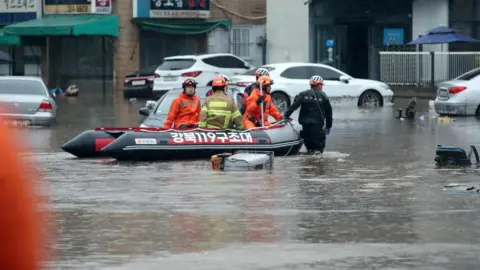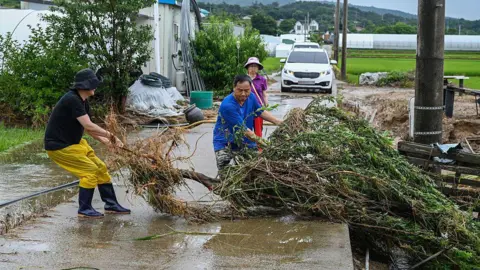Top Stories
Four dead, 1,300 evacuated as heavy rain drenches country

 Reuters
ReutersFour people have died and more than 1,300 evacuated as torrential rain pounds South Korea, with authorities warning that the unseasonal deluge will continue.
Among those killed were two men in their 80s. Authorities believe one of them was trying to drain floodwaters from the basement of his home.
A third victim was crushed when a wall collapsed onto his car. Moments before, he’d called his wife to say the vehicle was “being swept away”, authorities say. The fourth victim died of a cardiac arrest.
“I couldn’t understand how something like this could happen,” says Kim Ha-min, a cafe owner in the city of Gwangju. She says this is the first time she has experienced such heavy rain.
 Reuters
Reuters Reuters
ReutersThe record rainfall has prompted South Korea’s government to raise the weather-related disaster alert to its highest level.
“Everything is covered by water except the roof [of my house],” a resident in one of the affected areas wrote online.
More than 400mm of rain poured down in just half a day in Seosan, the worst-affected city, along the country’s west coast – the weather agency described it as a once-in-a-century event.
Photos and videos on social media show vehicles and homes submerged, with pieces of furniture floating in the water.
Ms Kim in Gwangju, which recorded 426mm of rainfall on Thursday, said she was scared because “I’ve never seen a flood here before, since there is no stream or river in this neighbourhood”.
The 26-year-old had to shut her cafe after it was inundated by floodwaters: “I drained the water, but the smell from the sewers is so bad that I can’t open for business.”
 Kim Ha-min
Kim Ha-minSeveral injuries were reported across the country, including two people suffering from hypothermia and two others who sustained leg injuries.
As of 16:00 local time (07:00 GMT) on Thursday, more than 1,300 people had been evacuated.
Authorities have urged people to stay away from riverbanks, steep slopes and underground spaces, warning that the risk of landslides and flash floods remains high.
Dry air from the north-west mixed with hot and humid air from the south to form especially large rain clouds, South Korea’s meteorological administration says.
But forecasters expect high temperatures to return next week, with the possibility of a heatwave.
 Getty Images
Getty ImagesTop Stories
A record supply load won’t reach the International Space Station as scheduled

The damage occurred during the shipment of the spacecraft’s pressurized cargo module from its manufacturer in Italy. While Northrop Grumman hopes to repair the module and launch it on a future flight, officials decided it would be quicker to move forward with the next spacecraft in line for launch this month.
This is the first flight of a larger model of the Cygnus spacecraft known as the Cygnus XL, measuring 5.2 feet (1.6 meters) longer, with the ability to carry 33 percent more cargo than the previous Cygnus spacecraft design. With this upgrade, this mission is carrying the heaviest load of supplies ever delivered to the ISS by a commercial cargo vehicle.
The main engine on the Cygnus spacecraft burns a mixture of hydrazine and nitrogen tetroxide propellants. This mixture is hypergolic, meaning the propellants ignite upon contact with one another, a design heralded for its reliability. The spacecraft has a separate set of less powerful reaction control system thrusters normally used for small maneuvers, and for pointing the ship in the right direction as it makes its way to the ISS.
If the main engine is declared unusable, one possible option for getting around the main engine problem might be using these smaller thrusters to more gradually adjust the Cygnus spacecraft’s orbit to line up the final approach with the ISS. However, it wasn’t immediately clear if this was a viable option.
Unlike SpaceX’s Cargo Dragon spacecraft, the Cygnus is not designed to return to Earth intact. Astronauts fill it with trash before departure from the ISS, and then the spacecraft heads for a destructive reentry over the remote Pacific Ocean. Therefore, a problem preventing the spacecraft from reaching the ISS would result in the loss of all of the cargo onboard.
The supplies on this mission, designated NG-23, include fresh food, hardware for numerous biological and tech demo experiments, and spare parts for things like the space station’s urine processor and toilet to replenish the space station’s dwindling stocks of those items.
Top Stories
Global Witness report: 80% of land defender deaths in Latin America

BOGOTA, Colombia (AP) — At least 146 land and environmental defenders were killed or have gone missing around the world in 2024, with more than 80% of those cases in Latin America, according to a report released Wednesday by watchdog group Global Witness.
The London-based organization said the region once again ranked as the most dangerous for people protecting their homes, communities and natural resources, recording 120 of the total cases. Colombia remained the deadliest country, with 48 killings — nearly a third of cases worldwide — followed by Guatemala with 20 and Mexico with 18.
The number of killings in Guatemala jumped fivefold from four in 2023, making it the country with the highest per capita rate of defender deaths in the world. Brazil registered 12 killings, while Honduras, Chile and Mexico each recorded one disappearance.
“There are many factors that contribute to the persistent high levels of violence in Latin American countries, particularly Colombia,” Laura Furones, lead researcher of the report, told The Associated Press. “These countries are rich in natural resources and have vast areas of land under pressure for food and feed production. Conflict over the extraction of such resources and over the use of such land often leads to violence against defenders trying to uphold their rights.”
Since 2012, Global Witness has documented more than 2,250 killings and disappearances of land and environmental defenders worldwide. Nearly three-quarters occurred in Latin America, including close to 1,000 cases since 2018, when the region adopted the Escazu Agreement — a treaty designed to protect environmental defenders. The pact requires governments to guarantee access to environmental information, ensure public participation in environmental decision-making and take timely measures to prevent and punish attacks against those who defend the environment.
“The Escazu Agreement provides a crucial tool for Latin America and the Caribbean,” said Furones. “But some countries have still not ratified it, and others that have are proving slow to implement and resource it properly. Stopping violence against defenders will not happen overnight, but governments must ramp up their efforts toward full implementation.”
Indigenous resistance
The report noted that Indigenous peoples bore a disproportionate share of the violence. They accounted for around one-third of all lethal attacks worldwide last year despite making up only about 6% of the global population. Ninety-four percent of all attacks on Indigenous defenders documented in the report occurred in Latin America.
In Colombia’s southwestern Cauca region, Indigenous youth are working to ensure they will not be the next generation of victims. Through community “semilleros,” or seedbeds, children and teenagers train in environmental care, cultural traditions and territorial defense — preparing to take on leadership roles in protecting land that has come under pressure from armed groups and extractive industries.
“We are defenders because our lives and territories are under threat,” said Yeing Aníbal Secué, a 17-year-old Indigenous youth leader from Toribio, Cauca, who spoke to AP in July.
These initiatives show how communities are organizing at the grassroots to resist violence, even as Colombia remains the deadliest country for defenders.
Small-scale farmers were also heavily targeted, making up 35% of the victims in the region. Most killings were tied to land disputes, and many were linked to industries such as mining, logging and agribusiness. Organized crime groups were suspected of being behind at least 42 cases, followed by private security forces and hired hitmen.
Colombia one of the worst hit
The Amazonian department of Putumayo in southern Colombia illustrates many of the risks faced by defenders. With its strategic location bridging the Andes and the Amazon, the region is rich in forests, rivers and cultural knowledge. But it also sits at the crossroads of armed conflict, extractive projects and illicit economies. Armed groups have long used the Putumayo River as a trafficking route toward Brazil and Ecuador, where weak controls make it easier to move cocaine, minerals and laundered money.
An environmental defender there, who asked to remain anonymous out of fear of reprisals, told AP this has created one of the most hostile climates in the country.
“Defending rights here means living under permanent threat,” the source said. “We face pressure from illegal mining, oil projects tied to armed groups, deforestation and coca cultivation. Speaking out often makes you a military target.”
Andrew Miller of the nonprofit Amazon Watch said transnational criminal networks involved in drug, gold and timber trafficking have become a major force behind threats — and often deadly attacks — against environmental defenders.
“The security situation for defenders across the Amazon is increasingly precarious,” Miller said.
___
The Associated Press’ climate and environmental coverage receives financial support from multiple private foundations. AP is solely responsible for all content. Find AP’s standards for working with philanthropies, a list of supporters and funded coverage areas at AP.org.
Top Stories
Vikings will put Aaron Jones on injured reserve

Vikings running back Aaron Jones is going to miss more than one game as a result of his hamstring injury.
According to multiple reports, Jones will be placed on injured reserve. That move will keep him out of at least the next four games.
The Vikings are signing running back Cam Akers to bolster their backfield options. Jordan Mason has been splitting time with Jones over the first two weeks and will move into the lead role in the Minnesota ground game.
Jones had 13 carries for 46 yards and three catches for 44 yards in the first two games of the season. He will miss this Sunday’s game against the Bengals as well as matchups with the Steelers, Browns, and Eagles. The Vikings have a bye in Week 6, so he will be eligible to return for the Vikings’ Week 8 Thursday night game against the Rams.
-

 Business3 weeks ago
Business3 weeks agoThe Guardian view on Trump and the Fed: independence is no substitute for accountability | Editorial
-
Tools & Platforms1 month ago
Building Trust in Military AI Starts with Opening the Black Box – War on the Rocks
-

 Ethics & Policy2 months ago
Ethics & Policy2 months agoSDAIA Supports Saudi Arabia’s Leadership in Shaping Global AI Ethics, Policy, and Research – وكالة الأنباء السعودية
-

 Events & Conferences4 months ago
Events & Conferences4 months agoJourney to 1000 models: Scaling Instagram’s recommendation system
-

 Jobs & Careers3 months ago
Jobs & Careers3 months agoMumbai-based Perplexity Alternative Has 60k+ Users Without Funding
-

 Podcasts & Talks2 months ago
Podcasts & Talks2 months agoHappy 4th of July! 🎆 Made with Veo 3 in Gemini
-

 Education3 months ago
Education3 months agoVEX Robotics launches AI-powered classroom robotics system
-

 Education2 months ago
Education2 months agoMacron says UK and France have duty to tackle illegal migration ‘with humanity, solidarity and firmness’ – UK politics live | Politics
-

 Podcasts & Talks2 months ago
Podcasts & Talks2 months agoOpenAI 🤝 @teamganassi
-

 Funding & Business3 months ago
Funding & Business3 months agoKayak and Expedia race to build AI travel agents that turn social posts into itineraries


